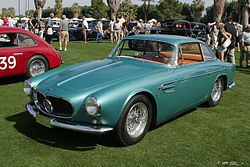Automobiles created
Some of the earlier cars Carrozzeria Allemano created were the Ferrari 166 S (which won the 1948 Mille Miglia with Clemente Biondetti behind the wheel), Alfa Romeo 2500 (1950) and Lancia Aurelia (1952). The Cisitalia 202 Berlinetta (#105, 1951) was designed by Carrozzeria Scaglietti and built by Allemano. [2]
For Fiat, Allemano created three Fiat 1100 TV (by Giovanni Michelotti, 1954), the Fiat 600 (1955-1958), a few Abarth 750, Fiat 850 and Fiat 2200. Some of the Fiat 600 designs were also used by Abarth and Siata. [2]
For Maserati, it made 21 Maserati A6G/54 coupés; four coupés, including the 1957 prototype of Maserati 3500 GT and 22 Maserati 5000 GT coupés (1959-1965). All of them designed by Michelotti.
For ATS, it built the ATS 2500 GT (1963) designed by Franco Scaglione. [3]
There was also a Jaguar XK140; an Aston Martin DB2/4 (1953); a Panhard Dyna; as well as Renault Dauphine specials.
- An Allemano bodied Ferrari 166 S winning the 1948 Mille Miglia in Italy
- Maserati A6G 2000 Coupé
- Abarth 750
- Maserati 5000 GT
- Abarth 1000 Scorpione Coupé
- Panhard Dyna
- ATS 2500 GT






